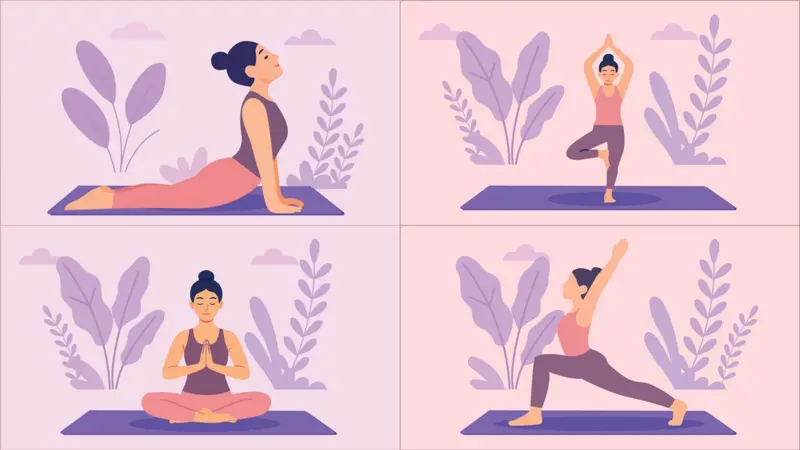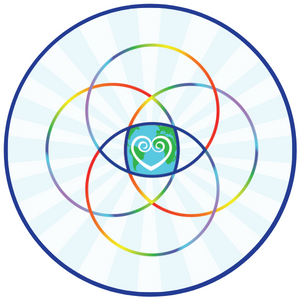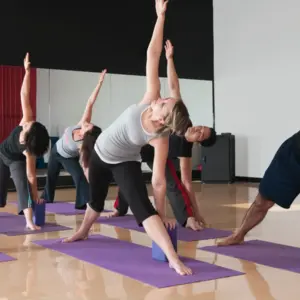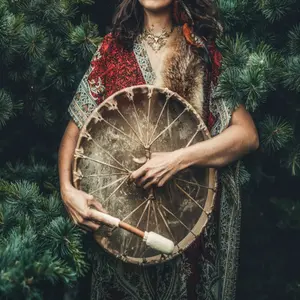

Traditional World Medicine

Traditional World Medicine
Guide to Yoga Practices
by Hannah Tytus
The word ‘yoga’ comes from the Sanskrit root yug, meaning to join together or yoke. It represents a set of precepts and practices to weave together the threads of the mind, body, and spirit.
The yogic lineage was originally an oral tradition but was transcribed by the Indian sage Patanjali in The Yoga Sutras 2,000 years ago. In this treatise, the path to harmony is realized through ethical practices (yamas and niyamas). The body’s organs and systems are to be cleansed first through asanas (postures) and pranayama (breathing techniques). Notably, the physical postures recognizable today were not the primary focus in the ancient works.
Yoga has evolved beginning with early spiritual texts like the Vedas and the Bhagavad Gita, which emphasized devotion, action, and meditation. Patanjali’s Yoga Sutras codified yoga as a system of ethical and mental discipline rather than physical practice. Centuries later, Hatha Yoga texts (1200–1500 CE) introduced structured physical practices, setting the stage for modern yoga classes, where the physical postures often take center stage.
Originally, the yoga asanas were used as a way to prepare the body and nervous system for the stillness of extended meditation. Western iterations of yoga often neglect its ethical and spiritual commitments, presenting it instead as a largely physical practice that now represents a multi-billion dollar business worldwide.
Due to the diversity of schools of thought, there are innumerable types of yoga, making it hard to know what to expect from a given class. While not an exhaustive list, the following are the common types of yoga practices. The practices are grouped into one of three categories: exercise-oriented, relaxation-focused, and philosophical styles.
Hatha
All yoga traditions that employ physical postures can trace their origins back to Hatha yoga.
Hatha is considered the foundational branch of physical yoga, with practices dating back to the first century CE and documented in the 11th century. This type of yoga brought a stronger emphasis to the use of physical postures. It is from the Hatha tradition that many other branches of yoga emerged throughout the 20th century, including vinyasa, ashtanga, Iyengar, Kemetic, and Kundalini.
Hatha, from ha meaning sun and tha meaning moon, represents the balance of masculine and feminine qualities within us and is a transformative practice that cultivates strength and flexibility, teaches effort and surrender in each pose, and guides attention to the breath to still the mind and deepen presence.
Hatha yoga is a gentle, slow-paced practice that emphasizes breathing exercises and foundational poses. It is well-suited for beginners or anyone seeking a calmer yoga practice. Classes often emphasize physical engagement, though they vary widely in pace, focus, and intent.
Strengths: Slower pace, ability to build a strong yogic foundation.
Considerations: May not be challenging enough for those seeking a more intense workout.
Variants: Sivananda yoga is a specific system of Hatha yoga that follows a fixed sequence of 12 poses in a prescribed order, emphasizing relaxation as well as holistic precepts for life beyond the mat.
Exercise-Oriented Yoga
Vinyasa
Vinyasa yoga is a dynamic, flowing style that links movement with breath. Often described as a dance-like practice, practitioners of Vinyasa move continuously through a series of poses, making it more physically engaging. Most sequences contain sun salutations, and this style allows for multiple creative permutations and variations of poses.
Strengths: Creative variety and fast-pace.
Considerations: Can be physically demanding and may not be ideal for beginners.
Variants: Some studios offer slow flow or other slower tempo alternatives. Power yoga is an offshoot of Vinyasa/Ashtanga, offering a high-intensity, strength-focus practice that focuses on the physical body rather than yogic principles.
Iyengar
Iyengar yoga focuses on precision, alignment, and posture of the body to achieve stability, safety and maximum benefit from each pose. This yoga style often employs props like blocks, straps, or blankets to achieve each pose. This can be good for beginners seeking detailed alignment instruction for core poses.
Strengths: Learning optimal pose positions and with careful step-by-step instruction.
Considerations: May not be intense enough for those seeking a vigorous workout and may require modifications for those with an injury.
Ashtanga
Ashtanga yoga is a vigorous, structured practice that follows a specific sequence of poses, often in a heated environment. Ashtanga yoga has a strong emphasis on discipline, typically involving lots of hands-on instruction, with teachers providing tailored guidance on proper alignment. Additional poses are not added until the teacher sees that the student has mastered the basics.
Strengths: Yoga for those that thrive on routine, regimented structure, and a disciplined practice. Sets strong physical foundation before moving on to more creative styles.
Considerations: Physically demanding; short hold times may limit restorative benefits. Repetitive motion injuries can result from any exercise where strain is continually placed upon the same areas.
Variants: Mysore style, the traditional way of teaching of Ashtanga, allows students to move through a set of postures at their own pace while receiving personalized, one-on-one guidance.
Hot Power
Hot power yoga takes place in a heated room, at temperatures between 95-105o F. Originally inspired by Bikram yoga, which consists of a 90-minute fixed sequence of 26 poses performed in a heated room, this style has evolved into a more flexible approach. As Bikram yoga has fallen out of vogue in the last decade due to allegations of sexual misconduct against its founder, many studios now offer hot power yoga instead, offering a heated environment that may be inspired by either dynamic Vinyasa or structured Ashtanga sequences.
Strengths: Offers detoxification benefits of a good sweat and an intense, challenging workout.
Considerations: Heat may be uncomfortable or unsafe for some people; not suitable for those with certain medical conditions.
Aerial
Aerial yoga uses a hammock or silk suspended from the ceiling to support movement, inversions, and deep stretches. The support of the fabric allows practitioners to playfully explore poses with less strain on the joints, while also offering playful opportunities for balance and core strength.
Strengths: Combines yoga with dance, acrobatics, and spinal decompression.
Considerations: Not suitable for people with joint instability, vertigo, or pregnancy (due to frequent inversions). Requires special equipment not present in all studios.
Variants: Acro Yoga is a playful, partnered and group activity for yoga and movement enthusiasts. Blending balancing postures with elements of Thai massage, it emerges from acrobatics and the circus arts rather than from a yogic tradition.
Relaxation-Focused Yoga
Yin
Yin yoga involves holding poses for long periods to stretch connective tissues and improve joint health. Yin yoga comes from the Hatha tradition. Its Western founders incorporate Taoist and traditional Chinese medicine principles of the meridians in the body to guide the practice. While the goal of restorative yoga is to relax, yin poses may include discomfort and intense sensation. Yin yoga primarily focuses on the lower body and may include pose holds from three to seven minutes in some cases. Through this process of long holds, the connective tissues around muscles (the myofascial layer) are targeted.
Strengths: Stretches connective tissue, cultivates patience, and explores deep stillness through long holds that target hips, pelvis, and spine.
Considerations: Low physical intensity; long holds may not suit everyone; not focused on strength or cardiovascular fitness. Yin yoga is most effective when the muscles are cold, making it an ideal practice in the morning.
Restorative
Restorative yoga is a slow, gentle practice where poses are held for extended periods with the support of props such as bolsters and blankets. This style emphasizes complete relaxation and nervous system regulation, making it especially useful for stress relief and recovery. Sessions often include only a handful of poses, each designed to encourage deep rest and subtle release.
Strengths: Deep relaxation, stress relief, or gentle support for healing from illness, fatigue, or emotional burnout.
Considerations: Not ideal for those seeking strength-building or cardiovascular benefits.
Yoga Nidra
Yoga Nidra is a guided meditation technique used to induce relaxation. Sometimes called yogic sleep, it is a simplified form of an ancient tantric yogic relaxation technique. It combines guided visualizations with the yogic asana savasana (corpse pose, lying down) to guide the student into a state of deep relaxation. It is physically accessible, as it does not require any special movements from the practitioner.
Strengths: Reduced stress, improved sleep, and meditation and relaxation without physical effort.
Prenatal
Prenatal yoga is specially adapted for pregnancy. It uses poses, breathwork, and relaxation techniques intended to support physical, mental, and emotional well-being during pregnancy. Prenatal yoga has been shown to improve sleep, reduce stress and anxiety, decrease lower back pain, nausea, headaches, and other common pregnancy discomforts. It has been shown in studies to lower stress hormones like cortisol and help with gestational hypertension.
Strengths: Safe, supportive movement, breathwork, and relaxation practices to ease discomforts and prepare for birth.
Considerations: Not all pregnancy situations are appropriate for yoga; those with high-risk pregnancies, certain medical conditions, or complications need medical clearance.
Philosophical Yoga
Kundalini
Kundalini yoga combines breathwork, movement, meditation, and chanting to promote spiritual growth and self-awareness. Kundalini yoga has been shown to reduce stress, support relaxation, and improve memory and executive function. It offers a focus on spiritual development and transformation.
Strengths: Promotes spiritual growth.
Considerations: May be unfamiliar or challenging for beginners; meditation and chanting may not appeal to everyone.
Variants: Tantra yoga focuses on similar subtle energies and offers a holistic path of Shaktism. Tantra is an older tradition, which incorporates principles of Kundalini energy.
Kemetic
Kemetic yoga, developed in the 1970s, is based on interpretations of ancient Egyptian (Kemetic) hieroglyphs. Co-founder Tirser Ra Hotep, along with his teacher Dr. Asar Hapi, proposed that certain hieroglyphs depict yoga postures, predating Indian yoga traditions by thousands of years. Mantras are drawn from ancient African languages rather than Sanskrit. Kemetic yoga offers a safe environment for Black and other POC practitioners to build supportive community. The pace is slow and deliberate, emphasizing precise alignment and deep focus. Unique poses, such as the Pose of Ausar, Pose of Min, and Pose of Selkhet, honor Kemetic deities.
Strengths: Slow, intentional movement.
Considerations: It may be difficult to find Kemetic yoga classes. Yin yoga offers similar pacing, but does not contain Kemetic’s unique poses and mantras.
Tantra
Tantra yoga is considered one of the oldest yoga traditions, predating Hatha style yoga and being one of the first feminist yoga traditions. Tantra emerged in the sixth century CE, transforming Hinduism and Buddhism. It conceptualized the Divine as a feminine power, or shakti, which resulted in a reevaluation of the female gender in society. Furthermore, the body, previously discarded as dirty and not a part of spiritual liberation, was understood as a manifestation of the Divine and thus a positive instrument of liberation..
While Tantra is often co-opted and misrepresented In the West as being primarily sexually focused, it is a broad, mystical, holistic path of spiritual evolution that emphasizes working with the subtle energy body, including the chakras, nadis, and Kundalini energy.
Tantric yoga practice decreases cortisol, the body’s stress hormone, in the short term while balancing cortisol over the longer term.
Strengths: Exploration of the spiritual and energetic dimensions of yoga and values the body as a sacred vessel.
Considerations: Some studios use the label of tantric yoga to market erotic somatic experiences. It is important to ask clarifying questions about a teacher’s training and lineage before attending. A significant aspect of Tantra is the role of the teacher or guru, along with initiation rites to ensure esoteric practices are learned safely. A qualified teacher should be able to clearly recite their teaching lineage.
Variants: Kundalini yoga shares several overlapping principles with Tantra, focusing particularly on the Tantric concept of kundalini energy. While Kundalini practitioners place greater emphasis on Hatha asana and rigorous breathwork, the Tantric path tends to be more gentle and subtle, incorporating chanting, devotional practices, and meditation.
Yoga is not a monolithic practice but a living tradition that has unfolded across centuries, cultures, and contexts. From its origins in meditative stillness to the diverse physical forms offered in studios today, yoga continues to adapt to the shifting needs of practitioners. Each style carries its own rhythm, philosophy, and benefits, yet all share the same underlying thread: the weaving together of body, breath, and spirit. Exploring these varied paths highlights the enduring versatility of yoga as both a discipline and a way of life.
REFERENCES
References:
- American Pregnancy Association. (n.d.). Prenatal yoga: Pregnancy health & wellness. Retrieved from https://americanpregnancy.org/healthy-pregnancy/pregnancy-health-wellness/prenatal-yoga/
- Baginski, C. (2020). Restorative yoga: Relax. Restore. Re-energize. DK Publishing.
- Batista et al. U.S. National Library of Medicine. (2015). Acute and Chronic Effects of Tantric Yoga Practice on Distress Index. PubMed. https://pubmed.ncbi.nlm.nih.gov/26248115/
- Brett Larkin. (n.d.). Tantra yoga. Retrieved from https://www.brettlarkin.com/tantra-yoga/#:~:text=Traditional%20Tantric%20Philosophy%20&%20Practice,symbology%20of%20god%20and%20goddess
- Contemplative Sciences Center. (n.d.). Ashtanga yoga. University of Virginia. Retrieved [date you accessed], from https://csc.virginia.edu/programs/ashtanga-yoga
- Embodied Philosophy. (n.d.). Tantra rediscovered: An emic view of its history and practice. Retrieved from https://www.embodiedphilosophy.com/tantra-rediscovered-an-emic-view-of-its-history-and-practice/#:~:text=Indeed%2C%20several%20prominent%20yoga%20teachers,maintain%2C%20and%20yoga%20is%20Tantra.
- Garfinkel, M., & Schumacher, H. R., Jr. (2000). Yoga. Rheumatic Disease Clinics of North America, 26(1), 125–132. https://doi.org/10.1016/S0889-857X(05)70126-5
- Iyengar, B. K. S. (1993). Light on the Yoga Sutras of Patanjali (Sutra 1.2). The Aquarian Press.
- Kamraju, M., Ali, M. A., & Krishnaiah, J. (2022). Different types of yoga as a sport. Asian Journal of Physical Education and Sport Science, 1(1), 51–58. https://doi.org/10.37256/ajopess.112023246
- Kuan, W.-H., Chen, Y.-L., Liu, C.-L., et al. (2022). Excretion of Ni, Pb, Cu, As, and Hg in sweat under two sweating conditions. International Journal of Environmental Research and Public Health, 19(7), 4323. https://doi.org/10.3390/ijerph19074323
- McGee, K. (2022, November 21). 11 types of yoga: A breakdown of the major styles. MindBodyGreen. https://www.mindbodygreen.com/articles/the-11-major-types-of-yoga-explained-simply
- McKinley, J. (2015, February 24). Cracks show in Bikram yoga empire amid claims of rape and assault. The New York Times. Retrieved from https://www.nytimes.com/2015/02/24/us/cracks-show-in-bikram-yoga-empire-amid-claims-of-rape-and-assault.html
- Medium. (n.d.). Practicing pause, patience and presence with Kemetic yoga. Retrieved from https://medium.com/new-earth-consciousness/practicing-pause-patience-and-presence-with-kemetic-yoga-cb4b8e1901d7
- National Center for Complementary and Integrative Health. (2023, August). Yoga: Effectiveness and safety. U.S. Department of Health & Human Services, National Institutes of Health. https://www.nccih.nih.gov/health/yoga-effectiveness-and-safety
- Pandi-Perumal, S. R., Spence, D. W., Srivastava, N., Kanchibhotla, D., Kumar, K., Sharma, G. S., Gupta, R., & Batmanabane, G. (2022). The origin and clinical relevance of Yoga Nidra. Sleep Vigil, 6(1), 61–84. https://doi.org/10.1007/s41782-022-00202-7
- Rakhshani et al. U.S. National Library of Medicine. (2012). The effects of yoga in prevention of pregnancy complications in high-risk pregnancies: a randomized controlled trial. PubMed. https://pubmed.ncbi.nlm.nih.gov/22884667/
- Roy, S., Biswas, A. K., & Sharma, M. (2025, September 24). Evidence-based clinical effectiveness of Kundalini yoga: Systematic review of RCTs across multiple health conditions. Alternative Therapies in Health and Medicine. Advance online publication. https://pubmed.ncbi.nlm.nih.gov/40985958/
- Shohani, M., Badfar, G., Parizad Nasirkandy, M., Kaikhavani, S., Rahmati, S., Modmeli, Y., & Soleymani, A. (2018, February 21). The effect of yoga on stress, anxiety, and depression in women. International Journal of Preventive Medicine, 9, 21. https://doi.org/10.4103/ijpvm.IJPVM_242_16
- Swamy, H. R. D., & Agoramoorthy, G. (2022). Evolution of yoga: From spiritual uplift to business outburst. Yoga Mimamsa, 54(1), 36–40. https://doi.org/10.4103/ym.ym_36_22
- The Voice Online. (2021, March 4). Why the Black community is reclaiming yoga. Retrieved from https://www.voice-online.co.uk/lifestyle/health-wellbeing/2021/03/04/why-the-black-community-is-reclaiming-yoga/
- Tran, M. D., Holly, R. G., Lashbrook, J., & Amsterdam, E. A. (2001). Effects of Hatha yoga practice on the health-related aspects of physical fitness. Preventive Cardiology, 4(4), 165–170. https://doi.org/10.1111/j.1520-037x.2001.00542.x
- Wikipedia. (n.d.). Kemetic yoga. In Wikipedia. Retrieved from https://en.wikipedia.org/wiki/Kemetic_yoga
- Wile, N. (2015). Yoga history, literature and philosophy, and the psychology of yoga. Yoga Education Institute. https://yogaeducation.org/wp-content/uploads/2024/09/Yoga-Philosophy-Literature.pdf
- Nadholta et al. (2021). Potential benefits of Yoga in pregnancy-related complications during the COVID-19 pandemic and implications for working women. https://journals.sagepub.com/doi/full/10.3233/WOR-203277
- Yoga Journal. (n.d.). Learn about Sivananda yoga and then try this classical sequence. Yoga Journal. Retrieved from https://www.yogajournal.com/practice/yoga-sequences/sivananda-yoga-and-classical-sequence/
- Your Inner Yogi. (n.d.). What is Kemetic yoga? Retrieved from https://yourinneryogi.com/what-is-kemetic-yoga-2/#:~:text=In%20addition%2C%20there%20are%20many,the%20benefits%20of%20Kemetic%20yoga?


 By
By







